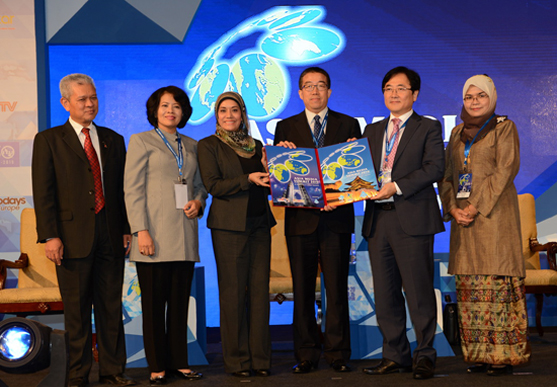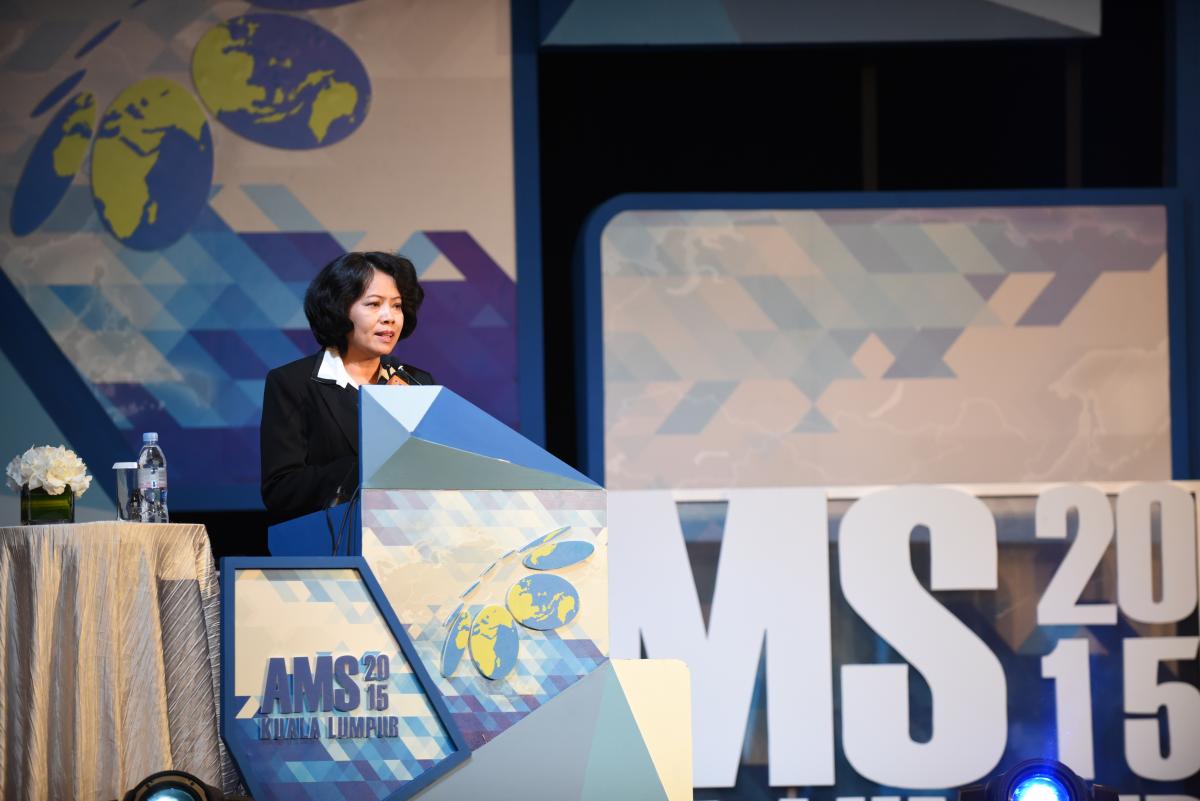Korea promises that the next Asia Media Summit to be held in Seoul from 24 – 26 May 2016 will be a fruitful, exciting and meaningful event.
Korea promises that the next Asia Media Summit to be held in Seoul from 24 – 26 May 2016 will be a fruitful, exciting and meaningful event.
“As host of the 13th AMS, we will ensure that this Summit is a future-oriented conference”, Mr. Sanghun Lee of the Multilateral Cooperation Division, Ministry of Science, ICT and Future Planning, Republic of Korea, said at the closing ceremony of the AMS 2015 in Kuala Lumpur, Malaysia on 28 May 2015.
Mr. Lee said that the Korean delegation has been learning from AMS 2015 in Kuala Lumpur, saying the government will exert best efforts to do the same.
A short video clip was presented highlighting various popular places participants can visit while in Korea.
In inviting local and foreign participants to Korea, Mr. Lee said participants will also have the opportunity to visit the production facility for the popular K Pop Group and hologram stations of KBS.
Dato’ Sri Dr. Sharifah Zarah Syed Ahmad, Secretary General, Ministry of Communications and Multimedia Malaysia in the witness of Mrs. Dra Rosarita Niken Widiastuti, President of the AIBD General Conference and President Director of Radio Republik Indonesia, and Mr. Chang Jin, AIBD Director,officially turned over to Mr. Lee a symbolic certificate signifying the change of host.
AIBD and the Korean Ministry have begun preparations to finalise the theme and topics as well as logistical requirements for the next Asia Media Summit.
Korea to host AMS 2016
Korea promises that the next Asia Media Summit to be held in Seoul from 24 - 26 May 2016 will be a fruitful, exciting and meaningful event.
Delivering Great Social Media Experiences
Laura-May Coope, Co-founder and Manager of Social Life, BBC, United Kingdom, urged radio broadcasters to derive maximum benefits from social media by inviting their listeners and fans in making them feel special and valued, creating emotional connections, and offering them rewards.
Big Challenges for Broadcasters
Dato’ Sri Ahmad Shabery Cheek, Minister of Communications and Multimedia of Malaysia, raised the possibility that viewers might stop watching TV in the traditional sense unless broadcasters dealt seriously with new trends impacting their industry, among them; the rising popularity of over-the-top or OTT services, the reach and influence of social media, and evolving media consumption behaviour.
Digital Transition in Asia-Pacific
Transition to DTTB services is a complex process yet necessary for broadcasters to remain in business in the longer term. Broadcasters who delay digital switchover transition will lead to increased costs and loss of revenues.
AIBD President Urges Broadcasters to Embrace Social Media
The 12th Asia Media Summit formally opened on 26 May 2015 in Kuala Lumpur, Malaysia, focused on the important role social media plays in transforming broadcasting into a stronger platform fit for now and the future
AMS 2015 : CEO Roundtable
Day 2 - Tuesday, 27th May 2015
1615 - 1730 : CEO Roundtable : Should Broadcasting Compete or Collaborate?
Broadcasting has dominated the communication industry, performing such roles as informing, educating, entertaining, and influencing opinion. Social media and emerging media share these roles. Consequently, they are pulling eyeballs away from television. Is broadcasting in a collision course with social media and to what extent? Should it consider social media competition in content creation, audience engagement and revenue generation? If so, how should broadcasters deal with this new player? Or should it collaborate as both platforms can provide what each other needs and influence people’s lives and routines? How far will collaborative strategies pay off for years to come? Should broadcasting embrace the power of social media to meet its business and civic obligations? Should both compete or collaborate?
AMS 2015 : Parallel Session 4
Day 2 - Tuesday, 27th May 2015
1400 - 1530 : Parallel Session 4 : New Approaches to Deal with Emergency Situations
Social media has become an integral part of disaster education, response and rehabilitation. It can contribute to public awareness as an emergency unfolds, help locate loved ones and notify and alert authorities, and co-ordinate response, recovery and volunteer efforts. It can support rumour management and correction of misinformation. How can broadcasters tap social media tools and manage their risks during emergencies? How do we deal with the risks? What are some best practices in planning for social media use before a disaster occurs, using popular and relevant social media tools, localising disasters in social media use, and in utilising mapping efforts?
AMS 2015 : Parallel Session 3
Day 2 - Tuesday, 27th May 2015
1400 - 1530 : Parallel Session 3 : Creative Content to Enrich Stories & Connect with Audiences
Broadcast organisations now have more access to content. Social media users participate in content creation and influence the type and nature of content. Some content are excellent; others full of abuse and spam. What is critical is to leverage social media to take advantage of compelling content and a rich variety of information sources. How is the creative industry dealing with new sources of content? What social media content is effective to enrich stories, connect with target markets and meet the viewers’ needs? With social media, how can broadcasters enhance various genres of programmes and collaborate in producing high-quality content and enhancing interactivity? What is the best time to post content to social networks?
AMS 2015 : Plenary Session 4
Day 2 - Tuesday, 27th May 2015
1100 - 1230 : Plenary Session 4 : Making Sense of Big Data and Social Data
We encounter so much information that is diverse and growing faster day by day. This big data is migrating to all types of human endeavour, demanding that we see and understand the relations within and among pieces of information and what one can do with it. Big data has become a significant corporate asset and economic input to fuel the information economy. Social media is streaming big data that is appropriate for real time analysis and for communicating information about rapidly changing situations. Social data is mostly non-curated and its reliability varies substantially. What new insights can broadcasters glean from big data and social data? How can broadcasters sift and analyse them to improve content, viewer engagement and operational efficiencies? What analytic tools are useful and effective to drive the value obtained from big data and social data throughout the organisation?
AMS 2015 : Plenary Session 3
Day 2 - Tuesday, 27th May 2015
0900 - 1030 : Plenary Session 3 : Defining and Implementing Legal and Regulatory Guidelines
As social media grows explosively, lawmakers and regulators grapple with important legal and regulatory issues to keep pace with the speed and impact of change. Guidelines to maximise social media’s benefits and protect the public and other stakeholders from its risks are critical. Broadcasters face a similar challenge as they increasingly use social media to inform, educate and influence their audiences and other stakeholders. What regulatory guidelines should be in place to handle the right to privacy, data protection, freedom of information, copyright infringement, and employee rights, among others? Should broadcast organisations do more self-regulation that will need a solid social media policy or should they prepare for more government regulation and stricter enforcement?









